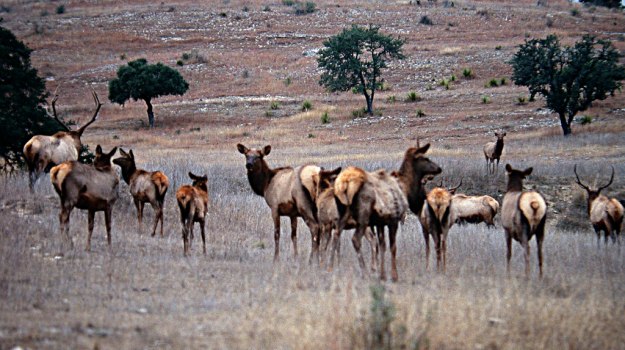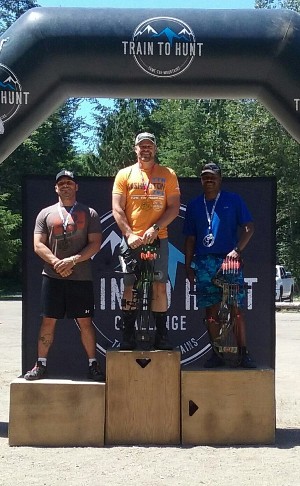
with Brian Mosley
I had planned a hunt in Colorado with my 15-year-old son Kenyon, who had a deer tag. I had an elk tag. Prior to this hunt, I realized I might have to help carry out an elk and a mule deer if Kenyon took one. So, I wanted to be in the best shape possible.
I started getting in shape for this hunt well in advance of the hunt. Because I'm a strength and conditioning, football and track coach, I knew that to perform at my best I had to get in the best shape I could before the hunt. I started training for the Train to Hunt Competition, a relatively new type of 3D archery competition that’s designed for bowhunters, especially elk and mule deer hunters, to simulate the tasks that these western hunters may have to perform. These competitions are held in all the western states. You also can learn more at their Facebook page.
Not only did I want to get my body and mind in shape for the hunt, but because I also shoot competitively for PSE, I liked the idea of competing in a new form of 3D archery. I'm always looking for that next challenge or the next new type of archery competition. I liked the idea of an archery competition that would help me prepare mentally, physically and with my bow for this hunt with Kenyon.
About four years ago, Kent Claremont from Oregon started the Train to Hunt Competition. These competitions are designed to challenge your body and your mind for hunting and shooting in the high country. Train to Hunt is a bowhunter competition for archers who shoot either traditional archery or hunt with compound bows. This competition has several different challenges.
One of the events is shooting a 20-target 3D competition, which is held on the first day, but this 3D competition is not like traditional 3D archery. When you arrive at a target, you may have to:
- judge the distance to the target, draw and shoot in a few seconds
- step out from behind a tree at full draw, judge the target quickly and shoot
- get an arrow off in 5 seconds
- get two arrows off in 10 seconds at the target
- shoot on your knees
- draw and shoot at targets often uphill or downhill, while sitting flat on the ground
 The second competition is called a meat carry. Depending on your age, you may have to carry a pack that weighs from 25 - 80 pounds. Because I'm in the Master’s Class, I have to carry an 80- pound pack over a 3-mile course to simulate carrying the meat out after you’ve taken an elk.
The second competition is called a meat carry. Depending on your age, you may have to carry a pack that weighs from 25 - 80 pounds. Because I'm in the Master’s Class, I have to carry an 80- pound pack over a 3-mile course to simulate carrying the meat out after you’ve taken an elk.
The third day is the 3D challenge. You'll wear a pack that weighs 20 to 25 pounds on your back and must run to six different stations over a 3-mile course. At every station you stop, look at a 3D target, guess the distance, take the shot and then follow the shot by a certain type of designated exercise like step-ups, push-ups, burpees and carrying a 100-pound bag 100 yards. Next you have to turn around and carry that same bag back to the starting point.
On the first day of this hunt, Kenyon took his first buck – a forked-horn buck - with his PSE Chaos bow at 23 yards – not far off the trail. Other than the day when Kenyon was born, this was the greatest day of my life. We were only about a half mile from where we’d left the truck. I got the truck fairly close to where the buck was. After field dressing him, we dragged him to the truck, loaded him up, left the woods, drove back home and finished butchering the buck. Happy and proud of his buck, Kenyon stayed home the next day. Besides, I think he thought his dad was crazy for climbing around in all the mountains that I hunted.
I left my truck at the same place where I’d left it the previous day and walked two miles farther into the woods from where Kenyon had taken his buck. I didn’t see any elk or deer on the first day I hunted. The next morning, I got up and discovered a herd of elk down in the bottom of what looked like a deep, dark hole in a canyon, about one and a half miles away. The hole actually was an 800-foot drop down in the canyon. Moving slowly and getting me to a place where the elk couldn’t spot me required about an hour and a half. Once I was within 400 yards of the elk, I took my shoes off and started calling like a cow elk as I moved closer and closer to the herd. A couple of times a some of the cows in the herd either saw or smelled me. Even though they ran off a little ways, they weren’t totally spooked.
When I finally got close to the herd, I sat down in front of a tree. I had elk from 25-50 yards from me. One of the bulls in the herd was a freak with five points on one side of his rack and three points on the other side that was chasing a cow. When the cow stopped, that bull stopped, and I shot him at 35 yards. I like taking freaky-racked bulls. Anytime one of those kinds of bulls gives me a shot, I'll take him.
I had to make two trips back and forth to my truck to get the meat out and another trip back and forth to get my camp out. That was when I could tell that my strength and conditioning practice and the Train to Hunt competition had paid off. On the two trips with the meat that I made to my truck, I had to climb out of that 800-foot hole with all that meat weight on my back.
Day 2: Brian Mosley’s Most Grueling Elk Hunt Ever
Tomorrow: Brian Mosley’s After School Bull Elk



























